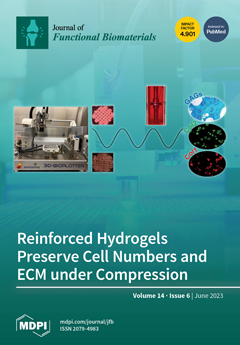This study investigated the influence of incorporating Biosilicate
® on the physico-mechanical and biological properties of glass ionomer cement (GIC). This bioactive glass ceramic (23.75% Na
2O, 23.75% CaO, 48.5% SiO
2, and 4% P
2O
5) was incorporated by weight (5%, 10%, or 15%) into commercially available GICs (Maxxion R and Fuji IX GP). Surface characterization was made by SEM (
n = 3), EDS (
n = 3), and FTIR (
n = 1). The setting and working (S/W time) times (
n = 3) and compressive strength (CS) were analyzed (
n = 10) according to ISO 9917-1:2007. The ion release (n = 6) was determined and quantified by ICP OES and by UV-Vis for Ca, Na, Al, Si, P, and F. To verify cell cytotoxicity, stem cells from the apical papilla (SCAP) were exposed to eluates (
n = 3, at a ratio of 1.8 cm
2/mL) and analyzed 24 h post-exposure. Antimicrobial activity against
Streptococcus mutans (ATCC 25175, NCTC 10449) was analyzed by direct contact for 2 h (
n = 5). The data were submitted for normality and lognormality testing. One-way ANOVA and Tukey’s test were applied for the working and setting time, compressive strength, and ion release data. Data from cytotoxicity and antimicrobial activity were submitted for Kruskal–Wallis’ testing and Dunn’s post hoc test (α = 0.05). Among all experimental groups, only those with 5% (wt) of Biosilicate
® showed better surface quality. Only M5% showed a comparable W/S time to the original material (
p = 0.7254 and
p = 0.5912). CS was maintained for all Maxxion R groups (
p > 0.0001) and declined for Fuji IX experimental groups (
p < 0.0001). The Na, Si, P, and F ions released were significantly increased for all Maxxion R and Fuji IX groups (
p < 0.0001). Cytotoxicity was increased only for Maxxion R with 5% and 10% of Biosilicate
®. A higher inhibition of
S. mutans growth was observed for Maxxion R with 5% of Biosilicate
® (less than 100 CFU/mL), followed by Maxxion R with 10% of Biosilicate
® (
p = 0.0053) and Maxxion R without the glass ceramic (
p = 0.0093). Maxxion R and Fuji IX presented different behaviors regarding Biosilicate
® incorporation. The impacts on physico-mechanical and biological properties were different depending on the GIC, but therapeutic ion release was increased for both materials.
Full article






